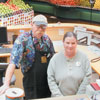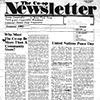
Co-op News Archive | Winter Quarterly 2019
It all started as a buying club…
From the Co-op News archive
From the Co-op News archive
I came to Arcata in July 1972. In August I heard there was a buying club organizing so I checked it out. It was a small office with a desk and a phone and a guy. Al Capone’s is there now. This guy was Jeff Schweitzer and he said he was just getting it together though there were members already. A membership cost $7.00 and then you could order food on Wednesday and pick it up Saturday. Well, there were no price lists and no food and it didn’t look together enough yet so we said we’d wait a while. Jeff left and Stephen Avis came up from Palo Alto where he’d work for their co-op. He decided we needed a store front with food on the shelves so in Nov., Nov. 6 to be exact, he bought some 350 dollars worth of groceries from a defunct market in McKinleyville with a personal check. By Feb., the store was in 1063 G Street where the Soup House is now. In March Stephen started ordering from Associated Co-ops. There were three orders in April alone – each over $700.00.
Then some trouble started and Stephen Avis left, taking his co-op connections with him. Ruth Balf had been working with Stephen and now she was left managing. There were people around who really wanted the store to go so there were meetings. The meeting where it was decided to incorporate as Arcata Co-op was attended by 20 voting members, many of whom are still around. They decided to make it go. We broke with the past management of the store – opened a different bank account so we could control the money. By now the Associated Co-op canned goods were gone and the store was existing on Foremost cheese which we bought in blocks and cut and wrapped ourselves. At this time – May 1973 – there were just a few people keeping the store alive. We did $85.00 worth of business on May 29. $72 on May 30. $40 on May 31. $105 on June 4 (Food Stamps always have been a big share of our business). There was one member, Steven Newmark who believed in taking chances. He called Dale Landing Produce Wholesalers in Eureka and ordered some fruit. This was June 25 and the order was for 1 box of cherries (20 lbs); 1 box of pink grapefruit (40 lbs); 1 box of oranges (88 lbs); 6 pineapple, and 15 dozen eggs at 58 c per dozen. This order totaled $38.45 and was a large risk at the time. The store had only two small donated refrigerators to sell dairy and cheese out of so the produce sat all day and night. Steven brought it home and put it in his refrigerator after picking over the cherries one by one to get rid of spoiled ones and keep losses down.
Slowly the store grew – people always buying whatever we could get in there. We made a deal with the International Peasant to bake us 6 loaves of bread a day. Steven drove to Associated Co-ops in Richmond and with $200 of his own money he filled his car trunk with Co-op peanut butter, margarine, flour, bonit. It sold and the money was reinvested in more stock. There was always so little in the store, people came in and found nothing to buy. We thought about hooking up a refrigerated case for produce and found the building we were in had concrete floors making drainage impossible. We had no money to move but the Seeley Titlow building was being vacated. They were selling out their stock. Some of us went over to look at the building. It was gigantic! All our shelving end to end wouldn’t reach from the front to the back of the store. We didn’t have enough for one aisle! Still we dreamed about how neat it would be – but we had no money. Again Steven Newmark took a risk. With his own money, he leased the Seeley Titlow building, paying rent for two months. When he told us – Ruth, Jim Johnson, and myself, we all though he’d made a mistake. He was overextending. Rushing things. He said – “Well, the building is there and it’s paid for if you want it.” We did. In three days we cleaned it, painted it, and moved the store. We wheeled the produce cases down the street. We trucked over the stock in the nine grocery carts. Sure glad it was downhill! Getting the store together was a big job and a lot of people gave of themselves to make it possible. There were a lot of aching backs and sore muscles and plenty of smiles too. We decided to make two aisles and leave space between the check out stands and the beginning of the aisles. One third of the store was empty. The shelves we had weren’t full. We still had the two little refrigerators and we hooked up one produce case as soon as we got enough membership fees. This was August. There were three volunteers running the store, the bathroom was much too far away. You had to ask a customer to watch the store for you. Well we made enough to pay the rent and all the new bills and loans. This community wanted a Co-op and that store really grew. Incorporation came at the end of August and September saw the store really take off. We began paying employees after four months in the new location. Ruth had gotten us contacts with wholesalers in Berkeley, San Francisco, Oregon, and San Jose. All the money made was put back into stock increases – growth was vital.
All we were concerned with was getting food – not trucking or wholesaling or dealing in bulk. We have been forced by the needs of this community to expand into these related areas. The Co-op is looking toward food production at this point.
I have really felt the Co-op grow. It used to be small enough for a very few people to really feel themselves as the impetus. This is no longer true. The Co-op is bigger than any few individuals. It has a force of its own now.
It is now May 1975. The Arcata Co-op is a retail storefront grossing $80,000 per month, a Bulk Food Center grossing $13,000 per month, owns and operates its own truck, is equipping a bakery (with more plans for food production), pays 18 employees $2.75/hr plus medical/dental benefits, has an educational program that is consistently expanding, and a committee that is involved in community services. There are 650 numbered memberships representing approximately 1,200 members. Even though the Co-op does seem to have a force of its own, it still must be responsive to its member-owners. As the Co-op expands and diversifies, it allows for much broader base for community input and participation. Every member should be encouraged to use the Co-op as a vehicle for effecting and implementing changes and ideas.




